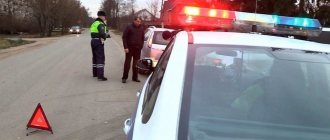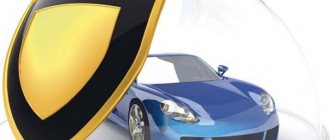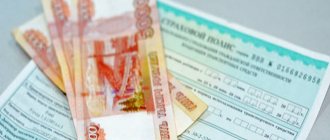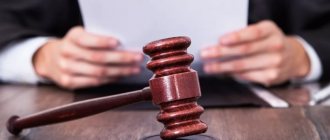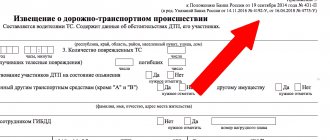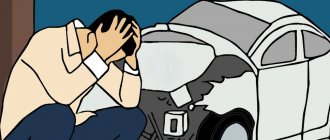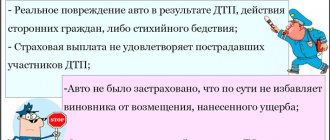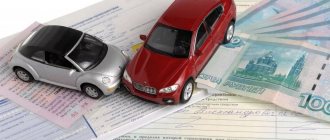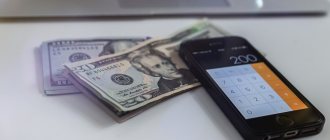The procedure for action in the event of an accident for the culprit and the victim
In almost any accident there is a culprit and a victim. Some of them did not show due care and made an unforgivable mistake that resulted in significant property damage and injury. What to do when this happened to you?
What to do after an accident if you are at fault or not at fault?
Every driver should know this algorithm of actions:
- stop the car;
- turn on the emergency lights;
- put up an emergency stop sign;
- if any parts fly off from the car, then you cannot touch them;
- if there are victims, then you need to clarify how many there are, call the police, an ambulance and provide first aid to the victims using your first aid kit.
If your own health allows, then you need to record the damage and position of the cars involved in the accident using photographs or video. It is best to take photos from afar and up close so that all damage is visible.
You need to exchange data with the injured party for further communication, as well as with witnesses, if any. It is also necessary to obtain information about the insurance company from the other party.
Next, you need to issue notifications about the accident, and then collect the signatures of all its participants. Usually a traffic police officer performs this task. He makes a decision on the accident on the spot, then all participants become familiar with it. If the at-fault driver does not agree with this decision, then it can be challenged, but no later than 10 days from the date of the accident.
The last stage will be checking all documents compiled on site, since the inspector may make a mistake. It is necessary to carefully read the certificate of the accident, the protocol and the resolution on the administrative offense.
Parties should remember to notify their insurance companies of the incident and obtain their instructions.
What to do after an accident if you are not at fault?
According to OSAGO, all initial actions will be the same, but then it will be necessary to continue to clarify the circumstances of the case with your insurance:
- Contact the insurance company of the person at fault and report the incident.
- Write a statement to the insurance company indicating all damage to the car. If the car was seriously damaged, then it is best to invite an auto expert to describe it.
- Make additional copies of documents.
At this point, you can leave the scene of the accident. In the future, you will only need to wait for the insurance payment. Usually the entire amount is transferred within 20 days. If this period is longer, the amount increases every day due to penalties.
It happens that after payments, when the owner of the car has already sent it for repairs, it turns out that the compensation received is not enough. Then the insurance company needs to provide receipts indicating that a certain amount is not enough to carry out repairs. Then they have to pay it.
Receiving compensation under compulsory motor liability insurance
After you have submitted an application to the insurance company, you can only wait for a referral for repairs to be issued or payments to be received. This must happen within 20 calendar days:
21. Within 20 calendar days, with the exception of non-working holidays, and in the case provided for in paragraph 153 of this article, 30 calendar days, with the exception of non-working holidays, from the date of acceptance for consideration of the victim’s application for insurance compensation or direct compensation for losses and the attached to it documents provided for by the rules of compulsory insurance, the insurer is obliged to make an insurance payment to the victim or, after inspection and (or) independent technical examination of the damaged vehicle, issue the victim a referral for repair of the vehicle indicating the service station where his vehicle will be repaired and where the insurer will pay for the restoration repair of the damaged vehicle, and the repair period, or send the victim a reasoned refusal of insurance compensation.
If the insurance company agrees to pay monetary compensation, the money will be transferred to the account you specified when submitting your application. If the amount received does not suit you, then you can conduct an independent examination and go to court for additional payments.
Good luck on the roads!
What to do if there are no victims in an accident, and also if there are any
Accidents happen under different conditions, so sometimes there are people injured and sometimes there are not. What to do in this or that case?
If there are no casualties in an accident, then it is not necessary to call the traffic police. Provided that the participants in the accident have no disagreements, the issue can be resolved on the spot. Such actions have been allowed since 2015.
Also, without the participation of traffic police officers, you can immediately contact the insurance company to prepare documents and request payments. However, there are mandatory conditions for this: there should not be more than two participants in the accident, and the drivers must also have compulsory motor liability insurance.
If any controversial issues arise, it is best to call the traffic police. They will create a complete picture of what happened and determine who is to blame and who is right. Sometimes, to draw up a report, the inspector may call the drivers involved in the accident to the traffic police department. Then the circumstances of the incident are determined using photographs or video files taken at the scene. In this case, cars must be removed immediately after photography, especially if they interfere with the passage of other vehicles.
If there are still victims of the accident, then it is necessary:
- with appropriate skills, provide first aid;
- immediately call the emergency room, report the victim, his condition, find out what actions should be taken and call a team of doctors;
- contact the traffic police and call them to the scene of the accident;
- If the condition of the victims is serious, then they need to be sent by passing transport to the nearest hospital department.
It happens that the victim needs urgent hospitalization, and no one except the second participant in the accident can take him. Then it is allowed to transport it in a car that is involved in the accident. The victim must be taken to the nearest medical facility, leave contact information, and then urgently return to the scene of the accident.
Report an incident
When an accident occurs on the road, it must be reported to the following organizations.
At the traffic police
When the issue with the victims has been resolved (damage to health has been assessed, an ambulance has been called), you need to call the traffic police. This can be done by the general number of the Ministry of Internal Affairs 102 or by number 101 - this is the number of the fire service and the Ministry of Emergency Situations.
Read also: Application for discharge from an apartment
If there is no way to reach these numbers, you need to call the rescue service on the same number for the whole country, 112. You can call this number from any operator, with a zero balance and even without a SIM card in your phone. After the operator answers, you need to ask him to connect to the nearest traffic police station.
The traffic police officer must immediately clarify the details of the accident by phone. If there is serious damage, casualties, more than 2 cars were damaged in an accident, or one of them does not have compulsory motor insurance, then traffic police officers are required to come to the scene of the accident.
There are cases when you can do without the participation of the traffic police:
- There is no injured party or both parties installed it themselves.
- The damage to transport was insignificant, not exceeding 50 thousand rubles according to preliminary estimates.
- Two cars were involved in the accident.
- Both drivers have insurance policies.
Important! Under such conditions, a notification of an accident (the so-called Europrotocol) is issued; it is necessary for contacting the insurance company.
To the insurance company
You need to call the insurance company when an insured event occurs. This is done immediately, immediately after the accident. This action can be performed via a phone call; some companies make it possible to notify about an accident online.
It is important to comply with the terms of application; they are usually specified in the insurance contract. Standard deadlines are 5 working days from the date of the accident. During this period, you must have time to send an application to the company.
If such an appeal occurs after this period, it may be extended. This is only possible when the payment of compensation will depend on the results of a civil or criminal case, or an administrative violation decision has not yet been issued, which usually indicates the guilty party. In all these cases, the deadline for filing an application is extended until all specified issues have been resolved.
If all deadlines are missed, then compensation for damage as a result of an accident is possible only in court. For such cases, there is a statute of limitations of 3 years from the date of the accident.
If it’s not your fault and there is compulsory motor liability insurance
If a citizen is not the culprit of the accident and has a compulsory motor liability insurance policy in his hands, he must:
- Contact your insurer for compensation as soon as possible. If possible, this is done directly from the scene of the accident, so that the insurers of the two parties agree among themselves.
- Conduct an independent examination to determine the amount of damage. You must pay for the examination immediately, but if you take a check, you can receive reimbursement of expenses.
- You must comply with the deadline for filing an application for compensation - 5 days from the date of the accident.
- Compensation is provided in one of three options: cash payment, wire transfer or restoration of the car at a service station that cooperates with the insurance company.
Registration of the Europrotocol in case of an accident
If an accident occurs, it can be processed according to the European Protocol. It was put into effect quite recently, but it has already proven itself quite well on the positive side. But for such a scenario, there should be no injuries in the accident, and there should be no disagreements among its participants, including the passenger. In addition, damage caused to equipment should not exceed 50 thousand rubles.
The advantage of the Europrotocol is that participants in an accident can complete it themselves, without waiting for traffic police officers. In this case, all the nuances of conflict resolution are discussed immediately on the spot.
The Europrotocol form is now issued to every driver whose car is insured under the OSAGO or CASCO program. If the document is lost or has already been used, a new form can be obtained from the nearest office of the insurance company. The form is filled out in the same way as a regular one.
The only peculiarity is that it is not the traffic police officer who is doing this, but the participants in the accident:
- On the front side you must indicate the location of the accident with its coordinates, as well as the date and time.
- Next, the number of damaged vehicles should be indicated, as well as the absence of injured persons. If there are witnesses to the incident, you need to enter their contact details.
- It is necessary to indicate the license plate number and other information about the damaged cars, as well as the details of their owners. At the same time, damage must be recorded both in writing and using photographs.
- It is also necessary to draw up a diagram of the accident. It should indicate houses, the direction of the road and cars at the time of the collision, in the form of rectangles. They are usually labeled "A" and "B". The arrows must indicate in which direction each of the designated vehicles was moving, and the cross indicates the location of the accident.
If at least one of the persons participating in the preparation of the Europrotocol expresses disagreement with the scheme or scope of damage, the amount of damage, or refuses to sign documents, then the situation will have to be resolved only with the traffic police officers.
Additional completion of road accident documents
Currently, most road accidents must be registered without the participation of police officers (New rules for registration of road accidents from July 1, 2015). The traffic police officers themselves are also in no hurry to go to the scene of “minor” accidents, and if they have already arrived, they do not deal with the registration, but “force” drivers to fill out the documents themselves. This complies with traffic regulations, so there is nothing to complain about here.
As a result of independently registering an accident, the injured driver ends up with only one document in his hands - a notification of a traffic accident . It is with this that you will have to contact the insurance company to receive compensation under compulsory motor liability insurance.
Note. From November 10, 2021, the notice can be filled out not only on a paper form, but also in electronic form (via an application). You can find out more about this in a separate article.
Let me remind you that at the scene of an accident, drivers together fill out only the front side of the notice. Each driver must fill out the reverse side independently.
The reverse side of the notice looks like this:
Let's consider filling it out.
14. Select a vehicle according to the front of the application. If your car was on the left, then select A, if on the right, then B.
15. Circumstances of the accident. This is the main item that needs to be filled out very carefully. I recommend formulating the text in advance (for example, in a computer text editor), and only then adding it to the notice.
This paragraph must contain, first of all, information about what the other road user has violated (including the traffic rules). In addition, you can additionally enter information to exclude your fault in the accident.
For example, you can specify:
I drove onto the Moscow highway. Stopped to comply with the requirement of sign 2.4 “Give way.” The driver of car B violated paragraph 10.1 of the traffic rules and caused a collision with a vehicle in front.
This explanation is quite enough to receive payment under compulsory motor liability insurance.
Cross out the remaining blank space to prevent adding unnecessary information there.
16. If the car was driven by the owner, then check the first box, if another person - in the second.
17. If the car cannot move under its own power, then check the second box and indicate the location of the vehicle.
18. Notes from participants. This field also requires completion. If you would like to attach photographs or video recordings to the notice, please write this in this field. For example:
I am attaching a CD with photographs of the scene of the traffic accident (43 photos) to the notice.
Also in field number 18, disagreements between the participants in the accident are indicated, if such disagreements occurred. Let me remind you that in case of disagreement, you can file an accident yourself only if you have an application from the union of auto insurers or the presence of the ERA-GLONASS system on at least one of the cars.
Cross out the remaining blank space.
In addition to notifying the insurance company, you will need:
1. All documents for the car (PTS, registration certificate, OSAGO policy).
2. Your documents (driver’s license, passport, power of attorney, etc.).
3. Bank details of your account printed on a sheet (if you do not want to repair the car, but want to receive money).
Note. In 2021, repairs take priority over cash payments. That is, in most cases, the insurance company will repair the damaged car.
If in your case a choice is possible, then it makes sense to think in advance which method of compensation you will choose: repairs or money.
repair if you really want to repair your car and it doesn’t matter to you who will do the repairs. If you choose repairs, the insurance company must pay for it in full, i.e. You are guaranteed to receive a restored car. A possible disadvantage of repairs is that it can take considerable time (a month or more).
money if you are not going to repair the car at all. For example, in the case of minor scratches.
It is also advisable to choose money if you are going to do the repairs yourself. Or you want to contact a trusted organization to restore your car.
I note that in practice, insurance companies often pay an amount that is not enough to completely restore the car. In this case, it is necessary to conduct an independent technical examination and recover the remaining amount from the insurance company through the court.
Note. From August 24, 2021, the driver is required to notify the insurance company 3 days in advance of the date and time of the independent examination.
Calling an emergency commissioner without the traffic police
Not all motorists have a sufficient level of knowledge to draw up documents about an accident. In addition, during an accident, drivers often become stressed, and in this state they are unable to do everything as it should. Of course, you can call the traffic police, but usually they take a very long time to get to the scene of the accident. In this case, it is best to call an emergency commissioner.
He will be a third party in an accident, which is necessary to assist in the preparation of documents and further actions. The main advantage of the commissioner is that he gets to the scene of the accident quickly - within 20-30 minutes after the call.
What actions can he perform:
- he will draw up a diagram of the accident,
- will record all damage,
- location of cars using photography,
- he will also need copies of the drivers' documents.
Further action is required on the part of the participants in the accident. They must write an explanatory note about the circumstances of the incident addressed to the head of the territorial traffic police department. After this, you need to call the traffic police officers or go to their department to register the accident with all the attached documents.
After this, the injured party in an accident must contact the insurer no later than 5 days after the accident.
Further actions of the driver
When all the initial points have been settled, it is important to understand how to proceed further.
What to do with the car
After an accident, a car owner usually has a question about whether or not it is worth repairing it and driving on. Such thoughts are especially common in the presence of severe damage. There are several options:
- Sell your vehicle to buy used cars. There are companies that do this. This option saves time and makes it possible to immediately receive a certain amount of money. This option is suitable for those who do not intend to restore their car and continue driving it. The disadvantage of this solution to the problem is that buyers will give a minimum amount of money for a damaged car.
- You can try to sell your used car yourself. This can take a long time, since few people would want to take on such a problem. The amount of money received from the sale is unlikely to be much greater than in the first case, and it will take much longer.
- Repair and sell. This is what those who want to spend a minimum of money on repairs try to do, and then profitably sell a damaged car as one that has never been involved in an accident. In some cases, scammers hide serious damage that violates the geometry of the body. If you follow this path, you need to be prepared for the truth to be revealed.
Read also: Heirs of the first stage according to law
Independent examination
An independent examination is an assessment of a vehicle by a third-party company to determine the actual damage received as a result of an accident. It is necessary if the car owner wants to make sure that the insurance company’s charges are correct, if there are suspicions of unaccounted for defects, or if a trial is planned. It will also be needed to determine the amount of car repairs.
In order to conduct an independent examination, you must:
- Select a company and conclude an agreement with it, pay for the service.
- Indicate the date and location of the vehicle inspection. To do this, you need a car service, where there are conditions for carrying out this procedure.
- Next, you need to notify the insurance company and the person responsible for the accident that an independent examination is being carried out. This is done by sending a letter to interested parties.
- Specialists conduct an examination and, based on its results, draw up a report: all calculations will be based on it.
- Further, with the help of special programs, these calculations are carried out in the same expert company. The result is a calculation of the necessary work and the cost of it.
- The final point is to get a report on the work done from an expert company.
What should the injured party do after registering an accident?
When the accident has already been registered, you can leave the scene of the accident. In some situations, the car leaves “under its own power”, but if the damage is serious, then it is taken to a tow truck.
To receive payments from the insurance company, an innocent driver must contact it no later than 15 days from the date of the accident and provide a package of documents:
- Notification of an accident.
- Application for payment.
- STS and PTS of the damaged vehicle.
- Insurance policy.
If an emergency commissioner takes over the trip to the insurer of the guilty party, he will additionally have to provide a notarized power of attorney to represent interests. This is more convenient, because then you can save time.
Typical driver mistakes after an accident
Now a few words about what you shouldn’t do so as not to find yourself in an unpleasant situation when the insurer refuses to compensate for the damage, or even the car owner risks receiving a fine or being punished in some other way.
- Any data is recorded incorrectly in the protocol, notification of an accident or other documents. It could even be something as simple as your date of birth, date of accident, or license plate number of your car. Everything should be calmly and carefully double-checked.
- No one takes photos or videos of the scene of the incident , and if they do, it’s in such a way that it’s impossible to see anything normally afterwards.
- The Europrotocol form is filled out incorrectly. Remember that notification of an accident always comes complete with instructions. Follow it when you fill out the document. Provide as complete information as possible in all columns. Try to depict the accident diagram very accurately.
- Participants in an accident, with mutual consent, decide not to contact the insurance company, but do not confirm their agreement with a receipt.
- They put their signatures on the protocol without first reading it.
- In a fit of emotion, out of stress, they commit rash actions, try to hide, strive to beat up the culprit of the accident, etc. This behavior risks the fact that instead of calmly registering an accident (even without the participation of traffic police inspectors), everything ends in the initiation of a criminal case.
Of course, no road user can be guaranteed to be insured against getting into an accident. This is not just about car or motorcycle owners. Quite often, pedestrians, public transport passengers, and people traveling in taxis are involved in road accidents. To minimize the risk of being in the middle of an accident, you should strictly follow traffic rules. And just in case, print out and carry with you in the car a small reminder of how to behave and what not to do if you do get into an accident. Or bookmark this article on your mobile phone, and then at any time you will have important and useful information at your fingertips.
What should a person at fault do after registering an accident?
Depending on what insurance policy the person responsible for the accident has, the procedure should be appropriate.
If the at-fault driver has a compulsory motor liability insurance policy, then after registering the accident it is necessary to obtain a protocol of the administrative offense, a certificate of the accident, as well as a resolution. You can then leave the scene of the accident. Subsequently, you need to monitor the process of collecting all documents for the insurance company by the victim.
It is also advisable to take photographs of the damage to the car in order to avoid disagreements in the future. If the injured party asks to inspect the car, then this should not be refused.
First steps
Free legal consultation
If an accident has already occurred, all that remains is to take the necessary actions. Moreover, this should be done by both the injured party and the guilty party.
Victim
Step by step process:
- First of all, the injured party must assess its damage and determine whether it is necessary to call an ambulance. Also, if possible, you need to see what’s wrong with the culprit of the accident; perhaps he will also need help.
- The next step is to call the traffic police. While they are getting to the scene of the accident, you need to ask the culprit if he has documents for the car. If the answer is yes, you should try to immediately get their photographs. Such documents include a license, a vehicle registration certificate and an insurance policy.
- You can immediately notify your insurance company about the occurrence of an insured event.
- If possible, it is better to immediately take several photographs of the incident and even shoot a video on the spot. In particular, you may need the length of the braking distance, the presence of fragments, and damage to your car. You can also remove any parts that seem important and are related to the accident.
- If there are witnesses to the accident, you should try to talk to them and save their phone numbers. It’s good if there were someone’s cars nearby, you can take recordings from their video recorders. The same goes for shops and other establishments - they also often have cameras.
- You need to carefully consider the condition of the road surface in a given place and what the weather conditions are. In general, it is necessary to evaluate the circumstances that could have become a provoking factor for the accident.
- Before the arrival of traffic police officers, under no circumstances should you move vehicles or other objects from the scene of the accident. This may disrupt the plausible picture of the incident and be seen as an attempt to influence the course of the investigation.
- It is prohibited to drink alcohol or take strong drugs immediately after an accident, as a medical examination may be required and the results may be incorrect.
- If the accident is minor, the traffic police may not arrive on site. In such cases, a Europrotocol is drawn up. This is only possible if the accident occurred with the participation of two cars, the drivers of which have a compulsory motor liability insurance policy, and the damage is insignificant - up to 100 thousand rubles.
Culprit
Mandatory actions for the person responsible for the accident:
- The guilty party must also receive video and photographic materials from the scene of the accident. Absolutely everything about the incident matters. It is equally important to photograph the victim’s car for damage, this will help avoid disagreements in the future.
- Obtain contacts and passport details of the victim. If there are witnesses, take data from them too.
- You should exchange insurance policy information with the victim (car owner).
- The next step is to file an accident report. The culprit must be sure that the victim put his signature on this notice.
- If the case is examined on the spot by traffic police officers, then the guilty party takes an active part in this. If the culprit does not agree with the decision of the traffic police officers, then in the protocol he makes a note “I do not agree” directly under his own signature. Then you will need to state your point of view of what is happening. There are 10 days from the date of the accident to challenge any result.
- It is important to receive the protocol and resolution of the administrative offense, a certificate of the accident. Documents are carefully checked on site and only then can they be signed.
- It is strictly forbidden to harm or threaten the injured party, this can only aggravate the situation.
- It is necessary to monitor how the victim collects documents and provides them to the insurance company.
- When a victim's car is being inspected, you should not refuse to participate. If there are any objections or comments, this must be written down in the act.
- You cannot immediately agree on the spot to all the victim’s claims for damages. It is necessary to propose that the issue be resolved in court.
- It is strictly forbidden to leave the scene of the accident, unless, of course, urgent hospitalization is required. For the fact that the culprit left the scene of an accident, additional liability is provided - administrative, and sometimes even criminal.
- The accident site needs to be fenced off and signs posted.
Read also: How to find out where a person is buried?
It is very good when the person at fault for the accident also has a CASCO policy. Then he will need to take the following steps in addition to the above:
- Pay special attention to the deadlines established in the CASCO agreement.
- Write a statement to the insurance company. After it is registered, make yourself a copy with the date and signature of a company employee.
- Get the insurance case number from the company, you can use it to receive all the information about the settlement.
- Take a referral for a vehicle inspection and provide the car for this procedure on the specified date.
How to act after an accident if you are at fault depends on the severity of the incident.
Accidental participant injured
Situations often occur when a person who happens to be in a given place at that time is injured in an accident. No special actions are required from accidental participants in the accident, especially if they did not receive severe or moderate injuries.
A person who has become an accidental participant must call an ambulance, and if this is not possible, then try to help the participants themselves. It is allowed to deliver victims to the nearest hospital in the car of an accidental participant in an accident (if he can move).
What to do if the culprit fled the scene of an accident
In some accidents, the at-fault driver leaves the scene of the accident. This usually happens to avoid punishment. In such cases, it is most often useless to arrange a chase. What's the best thing to do?
- In any case, the innocent party must record the accident.
- You also need to take photographs and videos. If this is not done, then punishment for leaving the scene of an accident will be provided for both participants in the accident, regardless of who is at fault.
- If your car has a DVR, then you immediately need to review the existing video and copy it to some medium.
- You also need to look for witnesses to the accident. If it happened in a city on a busy stretch of road, then there will definitely be witnesses.
If the culprit of the accident is found and his guilt is proven, he will be held administratively liable, and his insurer will be obliged to pay the amount to repair the injured party’s car.
If the culprit manages to escape and is not found, then the car will have to be repaired at your own expense.
Where to apply and with what documents
The first, and most correct step after an accident, is to notify the insurance company about the accident; it is advisable to do this immediately after the accident by calling the insurer.
After this, within five working days (in the case when a European protocol is drawn up) or no later than fifteen days (when calling the traffic police) in accordance with paragraph 2 of Article 11 of the Federal Law “On Compulsory Insurance...” N 40-FZ it is necessary will visit the insurance company.
If the victim is unable to come to the insurers in person, notification may be sent by mail or fax.
To receive payments you will need the following documents:
- certificate of an accident (when registering an accident involving traffic police officers) or a European protocol;
- documents for the damaged car, which will confirm ownership of it;
- expert opinion on the harm caused;
- other documentary evidence of damage to the vehicle.
If the victim proves the damage caused to his health at the time of the accident, the insurance company will compensate for this damage. The main rule in such cases is to document each claim.
To the driver
According to paragraph 2.5 of the Traffic Regulations, in the event of a traffic accident, the injured driver is obliged to:
- stop the vehicle, turn on the alarms;
- if there are victims, call an ambulance; if there is an urgent need to save the victim’s life, take measures to transport him to the hospital as soon as possible;
- if a car completely blocked road traffic during an accident, clear the roadway if possible;
- report the accident to the traffic police and your insurance company.
If the injured driver received any injuries, then he must take care not only of compensation for damage to the vehicle, but also for his own health, for this he will need to obtain a medical certificate.
Often, road accidents in which participants in the accident receive injuries and injuries involve vehicles that are on the balance sheet of an enterprise.
In such cases, an additional report of form N-1 “On an industrial accident” is drawn up.
A completed example of an act, form N-1.
A blank form of the act, form N-1.
The driver injured in the accident must carefully read all the documents and sign official papers if he agrees with what is stated in the document.
In situations where the driver does not agree with something, it is better to immediately call a car lawyer to the scene of the accident.
Passenger or pedestrian
Most often, passengers of vehicles receive the greatest injuries or injuries, because an accident is always unexpected for them, the person simply does not have time to react. In the event of an accident, they suffer harm to their health, but insurance for such cases is extremely rare.
In the event of an accident, the passenger must, if possible, follow the following procedure:
- leave the vehicle as quickly as possible and help other victims;
- move to a safe distance from the scene of the accident so as not to suffer even more from possible explosions if the car catches fire;
- if there are no serious injuries, help those more injured, if possible, provide them with first aid;
- do not leave the scene of the accident, with the exception of urgent medical care required;
- If possible, find witnesses and collect their contact information.
If a passenger has suffered any harm to their health in an accident, they should obtain a medical certificate, which will subsequently make it possible to receive compensation for physical harm.
Pedestrians are a category of road accident victims who, unlike vehicle passengers, are not inside the car, so they directly bear all the consequences of a collision between a person and a car.
The most important thing here is to prove that he received all the damage as a result of an accident, and not, for example, a fall from a height.
To do this, the required actions will be:
- calling the traffic police and ambulance;
- collecting contact information of witnesses.
After the victim is discharged from the hospital, he will need to receive a document indicating the injuries inflicted and the severity of the harm caused.
Then obtain information from the traffic police about the culprit of the incident and his insurance company. Next, contact this company with an application for payment of compensation for the damage caused by the person responsible for the accident.
Is an independent examination needed after an accident?
Each participant in an accident must decide the answer to this question for himself.
When contacting an independent expert, the amount of payments will be more accurate and, most likely, it will be enough to carry out high-quality repairs. The fact is that insurers, when assessing the damage caused, usually underestimate the final amount of payments, so you have to save money on restoring the car.
It is best to pay for the work of an independent expert and in the future receive an amount sufficient for a good repair. In such matters, saving is of no use.
Responsibilities of the victim
The culprit has 2 obligations after an accident:
- inform your insurance company about the insured event,
- do not repair the car until the insurer requests that the car be inspected within 15 days.
Let's take a closer look at the implications and intricacies of these responsibilities under the 2021 law.
How long does it take to notify the insurance company?
This must be done as soon as possible, but no later than 5 working days after the date of the incident. However, all this works in relation to the European protocol - that is, if you filed an accident without the participation of traffic police officers, then you are obligated to let the insurer know about the insured event as soon as possible in the form of transferring the European protocol to him. This is regulated by clause 3.8 of the Insurance Rules.
At the same time, please note that you need to formally fulfill this obligation so that you can confirm this in the future. After all, no one is safe from deception by the insurance company itself! That is, this can be done in writing by presenting your copy of the European protocol at the organization’s office under the incoming number and signature of the insurance employee, or by sending it by a valuable letter with a list of the attachments and a receipt.
Please note that you need to submit the notice to your insurance company, and not to the culprit.
The good news here is that there will be no consequences for the victim if he fails to fulfill his obligation to notify the insurer about the accident. In particular, the insurer has no right to refuse compensation for damages for this.
And for the culprit, liability in 2021 occurs in very rare cases. Below we will find out why.
Prohibition to repair a car
Another condition that applies only to registration of an accident using a European protocol is the obligation not to touch the damaged car for 15 calendar days, except for non-working holidays, for the victim. That is, please note that we are again talking about registering an incident without traffic police inspectors. This is dictated by paragraph 3 of Article 11.1 of the Law on Compulsory Motor Liability Insurance.
And here there are 2 conditions that cannot be done during these 15 days:
- obligation not to repair the vehicle,
- and another prohibition is not to dispose of the remains (for example, if the car is completely destroyed as a result of an accident).
But in this case, if the obligation is not fulfilled, there will already be consequences. Based on paragraph 20 of Article 12 of the same Federal Law, the insurance company has the right to refuse compensation to the victim if he presented for inspection an already repaired car or threw away its remains.
Please note that the legal requirement here must be taken literally: you do not have the right to repair the car within 15 days, but at the request of the insurer, you are required to show the car within 5 days. This means that even after these 15 days, if the insurance company requires you to present the vehicle for inspection in order to make a payment or repairs, then you need to show it - even if it has already been repaired.
Other responsibilities
All other obligations of the victim are directly related to the receipt of insurance compensation under compulsory motor liability insurance - that is, these are not obligations as such. You simply will not receive payment or a referral for repairs without fulfilling a number of conditions.
These conditions include:
- of course, collecting all the necessary documents to apply for compensation and writing an application,
- the victim must present the car for inspection or examination at the first request of the insurer, the period for this is 5 working days from the date of filing the application; Moreover, if the car is not running, then the insurer himself must come to the address where the car is located (clause 10 of article 12 of the Federal Law on Compulsory Motor Liability Insurance).
Should the victim contact the insurance company and within what time frame?
No. The right to MTPL insurance compensation for a victim in an accident is just a right, but not an obligation. Therefore, you have every right not to report damage to the insurer. And in this case, other responsibilities are also removed from you - including the requirement not to repair the car yourself for 15 days. However, the requirement of the law to notify the insurer about the insured event is not removed from you, but in this case, as we have already found out above, there is no liability, and hardly anyone will find out about the event - unless the culprit has a Casco policy in the same insurance company, and he will apply for compensation under this policy. But even here, neither the insurer nor the executive branch of the law can do anything to you.
But in practice, the deadline for applying for compensation in 2021 is considered to be the general statute of limitations - it is 3 years. Why is it accepted? Therefore, nothing is directly prescribed in any regulatory act regarding the timing of the victim’s request for compensation.
Work of an insurance company after an accident
It is now clear what those involved in an accident should do. However, how does an insurance company work? Initially, when she is notified of an accident, she will record it.
At the next stage, the insurer will accept documents from the injured party.
Required list:
- Russian passport,
- TIN,
- driver license,
- Vehicle title,
- certificate of an accident from the traffic police,
- OSAGO policy,
- as well as a certificate from a medical institution in case of damage to health.
Next, an expert from the insurance company will assess the damage to the car and determine the amount of payment. At the driver's request, this can be done by an independent expert. In this case, the assigned amount may differ.
In court, the accident case is considered within 10 days. During this period, the exact amount of payments will be assigned. If it does not suit the injured driver, then after this period a second application is submitted to the court.
If everything suits you, then all you have to do is wait for the compensation to arrive in your account. To speed up the process, the court decision can be withdrawn earlier - even before it enters into legal force, and transferred to the insurance company. However, payments will still be made within 90 calendar days. In some cases, it is paid in installments, especially if the amount is too large.
Contacting an insurance company for compulsory motor liability insurance
Before going to the insurance company to file a claim, I recommend calling them. The fact is that, firstly, you cannot submit an application at any office, and, secondly, not at any time (there must be an employee on site assessing the damage).
You will need to fill out an application with the insurance company, wait for the damage to the vehicle to be assessed and sign the corresponding document. In principle, nothing complicated, but in practice the whole procedure can take 2-3 hours of your time.
One more note. You need to go to the insurance company confident that you are right.
When I contacted the insurance company for payments, the employees said the following:
1. The notice was filled out with one hand, so you should not count on payments.
It is quite natural that the victim filled out the notice on his own. The culprit may intentionally make mistakes in order to avoid payments.
2. The copy of the notice does not say anywhere that the culprit admitted his own guilt.
This is also quite logical, because this copy of the notice is filled out by the victim. There are no fields reserved for the culprit. In addition, drivers are not generally required to independently determine the culprit of an accident. They only need to agree on the circumstances of the accident and the list of damages.
In general, if they tell you something like that, don’t be alarmed. The listed features of the notification do not affect the fact of payments.
Before giving the signed documents to the insurance officer, I recommend photographing them. Firstly, later you will be able to see what the insurance company wrote. Secondly, you will have evidence that you submitted documents to the insurance company at all.
Procedure for submitting documents to the insurer
Immediately after registering an accident, you must contact your insurance company and report the incident.
Next, you need to submit documents to the insurer as soon as possible, but before that, write an application there.
Required list of documents:
- passport of a citizen of the Russian Federation;
- TIN;
- driving license;
- PTS and STS;
- certificate of accident from the traffic police;
- OSAGO insurance.
After this, you just have to wait for an expert to evaluate the damaged car. He will then indicate how much will be paid for repairs, and the accident case will be sent to court.
The person at fault is required to provide the same list of documents to the insurance company. To do this, he is given a period of 3 days. If this deadline is missed, the insurer has the right to demand payment to the injured party from the culprit.
If any injuries were sustained as a result of the accident, they must be recorded at a medical institution and a certificate must be obtained. Then it also needs to be provided to the insurer. This must be done regardless of who you are in this situation - the culprit or the victim.
Some motorists trust this process to accident commissioners.
In this case, the commissioner must provide, in addition to the above documents, also a power of attorney for the car. It must be done by a notary. If the car was seriously damaged and was taken away from the scene of the accident by tow truck, then this must be confirmed by a certificate. It should indicate the costs of tow truck services.
Procedure for victims after an accident
The model of behavior of the victim in a traffic accident differs significantly from the actions that the culprit needs to perform.
When calling an inspector to the scene of an accident , it is necessary to obtain a copy of the protocol from the traffic police officers recording the incident. Next, within 3 years (Article 196 and Article 966 of the Civil Code of the Russian Federation), you must fill out the notice issued by the insurer when applying for an MTPL policy and submit it to your insurance company. Within 15 days, the insurance company is obliged to assess the damage to the vehicle and, within 20 days, make payments to the account of the driver injured in the accident.
In case of registration of the Europrotocol , within five days (clause 2 of Article 11.1 of Federal Law No. 40) from the occurrence of the insured event, the originals of the required documents and the completed Europrotocol form must be submitted to the insurance company. An authorized person from the Investigative Committee will set a date for inspecting the damaged vehicle. To subsequently receive compensation, you must provide the car to the experts within the specified period.
For your information
If the insurance company refuses to pay coverage after an accident has been registered, the victim can file a pre-trial claim with the culprit. Such a document is drawn up in any form, taking into account the mandatory information required by law, and is sent to the person whose guilty actions contributed to the damage to the car, by registered mail or letter with notification. If the answer is not received within the period provided by the victim, he has the right to apply to the court with a similar demand.
Driving schools began to teach how to register road accidents according to the European Protocol
In order to improve training, driving schools often supplement driver training courses. Not long ago, the Ministry of Education of the Russian Federation added to the training program of driving schools the procedure for registering minor accidents according to the Europrotocol.
In general, this type of form appeared in Russia relatively recently, and has greatly simplified the process of registering an accident for drivers. After all, motorists often get into minor accidents where there are no disagreements between both parties, and they want to resolve this issue as quickly as possible. However, due to the waiting of traffic police officers, it is not possible to speed up the process. The Europrotocol was introduced specifically for this purpose.
Some driving schools have not yet introduced such changes, while in some they have been in effect for a long time. The very first to learn how to correctly fill out the Europrotocol were students from Primorye driving schools.
What should the culprit do?
Here the requirements are a little stricter. Let's also look at them in order.
Notify about an accident
Just like the victim, the person responsible for the accident is obliged to send a copy of the accident notice to his insurer within 5 working days. But, unlike the victim, who faces no threat for failure to fulfill this obligation, the culprit in rare cases can suffer serious financial harm. Why in rare cases?
The fact is that not long ago they introduced changes to the law on compulsory motor liability insurance, abolishing the insurer’s right of recourse in the event of the culprit’s failure to comply with the requirement to send a European protocol to its insurer. And, since the provisions of the changes to civil relations are valid only after they come into force, the cancellation of the recourse requirement is relevant only for compulsory motor third party liability insurance contracts concluded after May 1, 2019. We wrote a separate article about this about the dangers of the European protocol.
